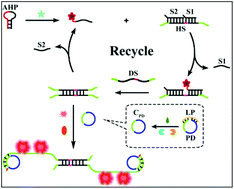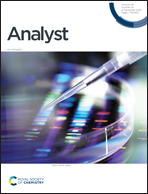The synchronization of multiple signal amplifications for label-free and sensitive aptamer-based sensing of a protein biomarker
Abstract
The abnormal variation of the mucin 1 (MUC1) protein level is associated with the development of multiple cancers, and the monitoring of trace MUC1 can be useful for early disease diagnosis. Here, on the basis of the synchronization of DNA-fueled sequence recycling and dual rolling circle amplification (RCA), the establishment of a non-label and highly sensitive fluorescent aptamer-based detection strategy for the MUC1 protein biomarker is described. The target MUC1 binds the aptamer hairpin probe and causes its structure switching to release an ssDNA tail to trigger the recycling of the complex via two toehold-mediated strand displacement reactions under assistance of a fuel DNA. Such a recycling amplification leads to the formation of a partial dsDNA duplex with two primers at both ends, which cooperatively bind the circular DNA ring template to start the dual RCA to produce many G-quadruplex sequences. The protoporphyrin IX dye further associates with the G-quadruplex structures to show a dramatically elevated fluorescent signal for sensitively detecting MUC1 with a low detection limit of 0.5 pM. The established aptamer-based detecting strategy is also highly selective and can realize assay of MUC1 in diluted human serums, highlighting its potential for the detection of different protein biomarkers at low contents.



 Please wait while we load your content...
Please wait while we load your content...